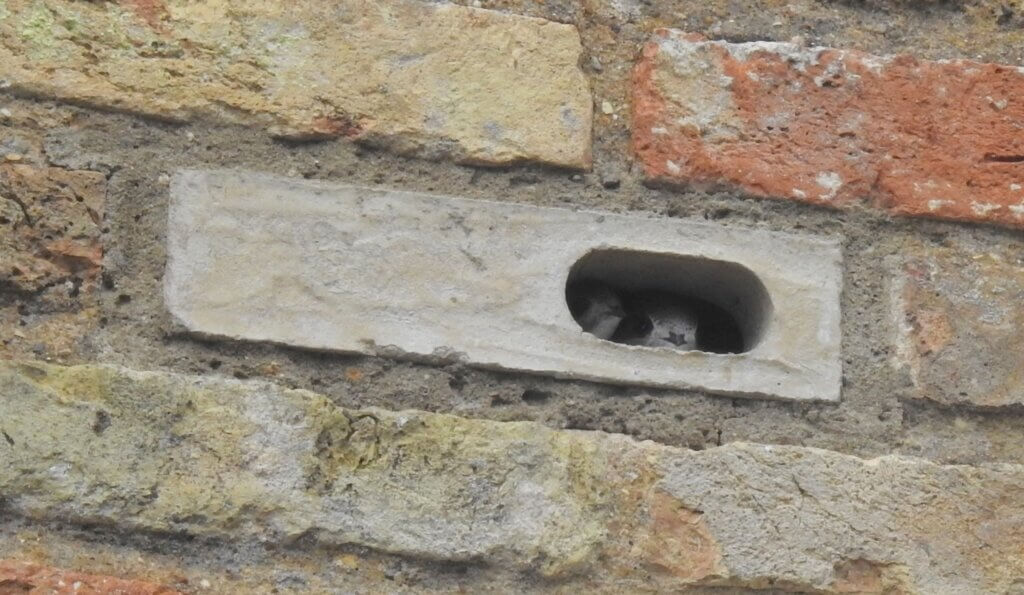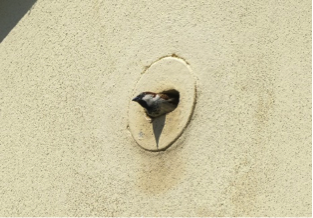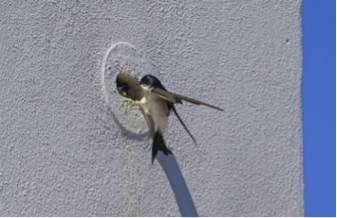
Lifetime bird watcher and over 60 years an RSPB member, Dick Newell, retired from the software industry, now devotes time to devising ways to help Swifts, which led recently to the BTO giving a Marsh Award for Innovative Ornithology to Action for Swifts. actionforswifts.com documents a large number of case studies, designs and ideas.

Swift Bricks – the ‘universal’ nest brick
The government wishes to build 300,000 homes per year over the next few years. At the same time, government planning guidelines say that any new residential development should attain a “10% net gain in biodiversity” (Ref 1).
The metric for biodiversity net gain is focused on green habitats and there is no means of accounting for the provision of nest boxes on dwellings as part of this process. There is a blind faith that these new green habitats can be maintained for wildlife in the longer term, while doubling up as amenity areas in close proximity to housing, and that biodiversity will be enhanced.
Undoubtedly some birds may move in – Robins may find a nest place in a green wall and Blackbirds in some of the shrubs. Although Blue Tits may use the odd nest box put up by a few conservation-minded residents, what about provision for cavity nesting species?
Well, The National Planning Policy Guidelines (NPPG issued 21/07/2019) under paragraph 23 headed “How can biodiversity net gain be achieved?” say:
“Relatively small features can often achieve important benefits for wildlife, such as incorporating swift bricks and bat boxes in developments and providing safe routes for hedgehogs between different areas of habitat” (Ref 2)
There is a range of cavity-nesting creatures that would benefit from integral nesting or roosting sites including several species of bird, bats and insects.
The Royal Institute of British Architects (RIBA) in their book “Designing for Biodiversity – second edition” recommends:
“As a guideline, the number of built-in provisions of nest or roost sites per development should be approximately the same as the number of residential units “ (Ref 3)
A number of planning authorities have adopted this guideline, which is based on the standard set by Exeter City Council in their award-winning Design Guide, in either Supplementary Planning Documents or Technical Advice Notes – for example Cornwall, Oxford, Brighton and Plymouth and South West Devon. Also, The Duchy of Cornwall is implementing this standard on a number of large developments in South West England and is supporting a project to monitor the species that take up these new nest sites.
However, many planning authorities mandate much less than this, typically between 10% and 20% of dwellings and in many cases none. Few authorities have the resources to monitor implementation resulting in lack of enforcement when developers do not comply.
Aside from this, many planning conditions specify inappropriate or an unbalanced provision of nest or roosting sites such as the absurd e.g. nest boxes for Song Thrushes!
Frequently large numbers of ‘sparrow terraces’ are specified. A sparrow terrace contains 3 nest chambers for sparrows. One may see conditions like “10 Swift bricks and 20 sparrow terraces” in a 200-house development – that’s 60 nest places for sparrows vs 10 for swifts. There are ~100 pairs of House Sparrows to every single pair of Swifts in the country. The House Sparrow population has been stable for the last 25 years, whereas the Swift continues to decline at about ~5% per annum. In any case, the sparrows will move into the swift boxes.
The Swifts Local Network (SLN) Swifts & Planning Group has produced a paper advocating the provision of Swift bricks as a preferred solution for a range of small cavity-nesting species. It comes from a realisation that this will have better outcomes for these species than trying to satisfy all species independently.
The paper makes the points that integral or internal nest boxes are:
- more aesthetically pleasing
- maintenance free
- long lasting
- less prone to predation
- less prone to temperature variations
The paper does not address species that prefer open-fronted nest boxes or nest boxes suitable for mounting externally.

Photo: Hugh Hastings and the Duchy of Cornwall
The main thrust of the paper is to counter the current tendency to provision large numbers of sparrow terraces. There is mounting anecdotal evidence that they have very low occupancy rates and that House Sparrows prefer Swift boxes.
A prime example is Fulbourn Cambs where 276 Swift boxes are home to ~100 pairs of Swifts as well as numbers of House Sparrows, Starlings, Great Tits and even House Martins. 50 sparrow terraces (150 nest places) in the same development contain no sparrows, just the occasional pair of Great Tits or Blue Tits.

Photo: Hugh Hastings and the Duchy of Cornwall
A one-size-fits-all policy is not only more effective, it simplifies things for ecologists, planners and builders. Further, whereas Swift boxes can accommodate House Sparrows, Tree Sparrows, Blue Tits, Great Tits, occasionally House Martins and, with a larger entrance, Starlings, sparrow terraces cannot accommodate Swifts.
You can download the paper, written by Camilla Barlow, Mike Priaulx, and SLN Swifts & Planning Group, here: PDF
References:
[registration_form]
Our estate has recently announced a ” Making space for wildlife” initiative.
As they are also involved in a large residential development , elsewhere in the county, i will contact our sustainability officer about this.
Trapit – thanks for that and thanks for all your comments here in 2020. Best wishes for 2021!
Hi Mark, thanks for this, your clarity on the subject and sharing the Duchy report. Hopefully soon many developers will be using the swift brick as the universal integral nestbox. Thaís